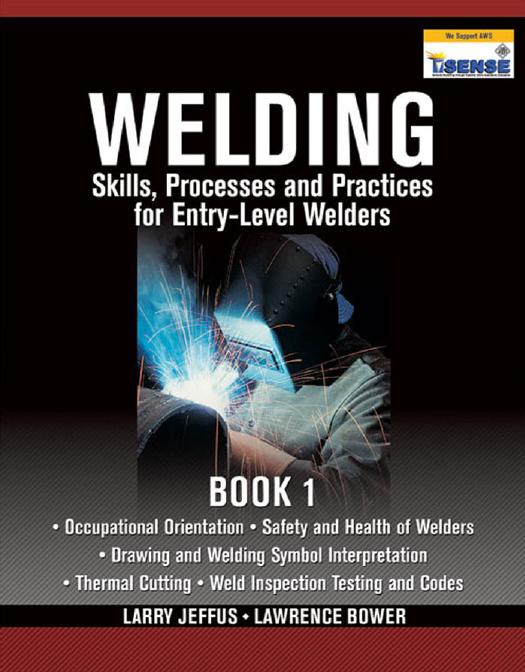Welding Skills, Entry-Level 01 by Welding

Author:Welding
Language: eng
Format: epub, pdf
178
CHAPTER 6
A W S S E N S E E G 2 . 0
Key Indicators Addressed in this Chapter:
Module 8: Thermal Cutting Processes
Unit 1: Manual Oxyfuel Gas Cutting (OFC) Key Indicators Key Indicator 1: Performs safety inspections of manual OFC
equipment and accessories
Key Indicator 2: Makes minor external repairs to manual OFC
equipment and accessories
Key Indicator 3: Sets up for manual OFC operations on carbon steel Key Indicator 4: Operates manual OFC equipment on carbon steel Key Indicator 5: Performs manual OFC straight, square edge, cutting operations, in all positions, on limited thickness
range of carbon steel
Key Indicator 6: performs manual OFC shape, square edge, cutting operations in all positions, on limited thickness
range of carbon steel
Key Indicator 7: Performs manual OFC straight, bevel edge, cutting operations, in all positions, on limited thickness
range of carbon steel
Key Indicator 8: Performs manual OFC scarfing and gouging operations to remove base and weld metal, in 1G
and 2G positions, on carbon steel
Unit 2: Mechanized Oxyfuel Gas Cutting (OFC)
Key Indicator 1: Performs safety inspections of mechanized OFC
equipment and accessories
Key Indicator 2: Makes minor external repairs to mechanized OFC
equipment and accessories
Key Indicator 3: Sets up for mechanized OFC operations on carbon steel
Key Indicator 4: Operates mechanized OFC equipment on carbon steel
Key Indicator 5: Performs mechanized OFC straight, square edge, cutting operations, in 1G and 2G positions, on
limited thickness range of carbon steel
Key Indicator 6: Performs mechanized OFC straight, bevel edge, cutting operations, in 1G and 2G positions, on limited
thickness of carbon steel
Module 9: Welding Inspection and Testing Principles
Key Indicator 1: Examines cut surfaces and edges of prepared base metal parts
INTRODUCTION
Oxyfuel gas cutting (OFC) describes a group of oxygen cutting processes that use an oxyfuel gas flame to heat metal to its kindling temperature before a high-pressure stream of oxygen is directed onto the metal to cut it. The kindling temperature of a material is the temperature at which rapid oxidation (combustion) can begin. The kindling temperature of steel in pure oxygen is 1600°F to 1800°F
(870°C to 900°C). The OFC processes are identified by the type of fuel gas used
Flame Cutting
179
Table 6.1 Fuel Gases Used for Flame Cutting
Fuel Gas
Flame (Fahrenheit)
Temperature* (Celsius)
Acetylene
5589°
3087°
MAPP®
5301°
2927°
Natural gas
4600°
2538°
Propane
4579°
2526°
Propylene
5193°
2867°
Hydrogen
4820°
2660°
*Approximate neutral oxyfuel flame temperature.
with oxygen to produce the preheat flame. Oxyfuel gas cutting is most commonly performed with oxyacetylene (OFC-A). Table 6.1 lists a number of fuel gases used for OFC. MPS (MAPP®) gas is increasingly being used today for cutting and rivals acetylene’s popularity in some areas of the United States.
More welders use the oxyfuel cutting torch than any other welding process.
The cutting torch is used by workers in virtually all areas, including manufacturing, maintenance, automotive repair, railroad work, farming, and more. Unfortunately, it is one of the most misused processes. Most workers know how to light the torch and make a cut, but their cuts are of very poor quality. Often, in addition to making bad cuts, they use unsafe torch techniques. A good oxyfuel cut should be straight and square and should require little or no postcut cleanup. Excessive postcut cleanup results in extra cost, which is an expense that cannot be justified.
Download
This site does not store any files on its server. We only index and link to content provided by other sites. Please contact the content providers to delete copyright contents if any and email us, we'll remove relevant links or contents immediately.
| Drafting & Mechanical Drawing | Fluid Dynamics |
| Fracture Mechanics | Hydraulics |
| Machinery | Robotics & Automation |
| Tribology | Welding |
Whiskies Galore by Ian Buxton(40329)
Introduction to Aircraft Design (Cambridge Aerospace Series) by John P. Fielding(32338)
Small Unmanned Fixed-wing Aircraft Design by Andrew J. Keane Andras Sobester James P. Scanlan & András Sóbester & James P. Scanlan(32141)
Craft Beer for the Homebrewer by Michael Agnew(17445)
Turbulence by E. J. Noyes(7037)
The Complete Stick Figure Physics Tutorials by Allen Sarah(6638)
Kaplan MCAT General Chemistry Review by Kaplan(6053)
The Thirst by Nesbo Jo(5785)
Bad Blood by John Carreyrou(5768)
Learning SQL by Alan Beaulieu(5410)
Weapons of Math Destruction by Cathy O'Neil(5036)
Man-made Catastrophes and Risk Information Concealment by Dmitry Chernov & Didier Sornette(4735)
iGen by Jean M. Twenge(4702)
Digital Minimalism by Cal Newport;(4540)
Life 3.0: Being Human in the Age of Artificial Intelligence by Tegmark Max(4507)
Audition by Ryu Murakami(4098)
1,001 ASVAB Practice Questions For Dummies by Powers Rod(4038)
Electronic Devices & Circuits by Jacob Millman & Christos C. Halkias(4027)
Pale Blue Dot by Carl Sagan(4001)
